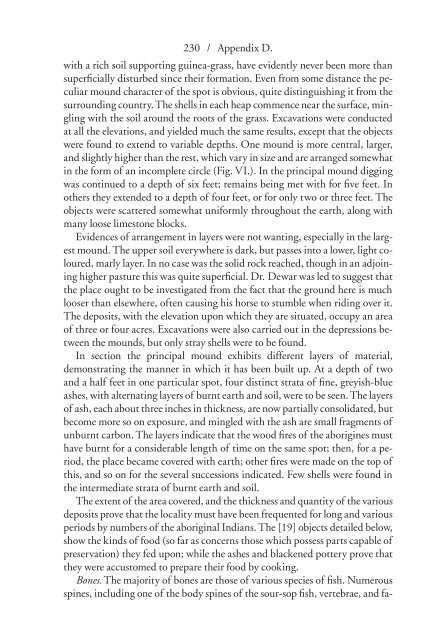Pre-Colombian Jamaica: Caribbean Archeology and Ethnohistory
by Phillip Allsworth-Jones
by Phillip Allsworth-Jones
You also want an ePaper? Increase the reach of your titles
YUMPU automatically turns print PDFs into web optimized ePapers that Google loves.
230 / Appendix D.<br />
with a rich soil supporting guinea- grass, have evidently never been more than<br />
superficially disturbed since their formation. Even from some distance the peculiar<br />
mound character of the spot is obvious, quite distinguishing it from the<br />
surrounding country. The shells in each heap commence near the surface, mingling<br />
with the soil around the roots of the grass. Excavations were conducted<br />
at all the elevations, <strong>and</strong> yielded much the same results, except that the objects<br />
were found to extend to variable depths. One mound is more central, larger,<br />
<strong>and</strong> slightly higher than the rest, which vary in size <strong>and</strong> are arranged somewhat<br />
in the form of an incomplete circle (Fig. VI.). In the principal mound digging<br />
was continued to a depth of six feet; remains being met with for five feet. In<br />
others they extended to a depth of four feet, or for only two or three feet. The<br />
objects were scattered somewhat uniformly throughout the earth, along with<br />
many loose limestone blocks.<br />
Evidences of arrangement in layers were not wanting, especially in the largest<br />
mound. The upper soil everywhere is dark, but passes into a lower, light coloured,<br />
marly layer. In no case was the solid rock reached, though in an adjoining<br />
higher pasture this was quite superficial. Dr. Dewar was led to suggest that<br />
the place ought to be investigated from the fact that the ground here is much<br />
looser than elsewhere, often causing his horse to stumble when riding over it.<br />
The deposits, with the elevation upon which they are situated, occupy an area<br />
of three or four acres. Excavations were also carried out in the depressions between<br />
the mounds, but only stray shells were to be found.<br />
In section the principal mound exhibits different layers of material,<br />
demonstrating the manner in which it has been built up. At a depth of two<br />
<strong>and</strong> a half feet in one particular spot, four distinct strata of fine, greyish- blue<br />
ashes, with alternating layers of burnt earth <strong>and</strong> soil, were to be seen. The layers<br />
of ash, each about three inches in thickness, are now partially consolidated, but<br />
become more so on exposure, <strong>and</strong> mingled with the ash are small fragments of<br />
unburnt carbon. The layers indicate that the wood fires of the aborigines must<br />
have burnt for a considerable length of time on the same spot; then, for a period,<br />
the place became covered with earth; other fires were made on the top of<br />
this, <strong>and</strong> so on for the several successions indicated. Few shells were found in<br />
the intermediate strata of burnt earth <strong>and</strong> soil.<br />
The extent of the area covered, <strong>and</strong> the thickness <strong>and</strong> quantity of the various<br />
deposits prove that the locality must have been frequented for long <strong>and</strong> various<br />
periods by numbers of the aboriginal Indians. The [19] objects detailed below,<br />
show the kinds of food (so far as concerns those which possess parts capable of<br />
preservation) they fed upon; while the ashes <strong>and</strong> blackened pottery prove that<br />
they were accustomed to prepare their food by cooking.<br />
Bones. The majority of bones are those of various species of fish. Numerous<br />
spines, including one of the body spines of the sour- sop fish, vertebrae, <strong>and</strong> fa-


















